This week in the shop
We are no longer building saddle trees, but we have two videos about how Western saddles fit horses available on our westernsaddlefit.com website.
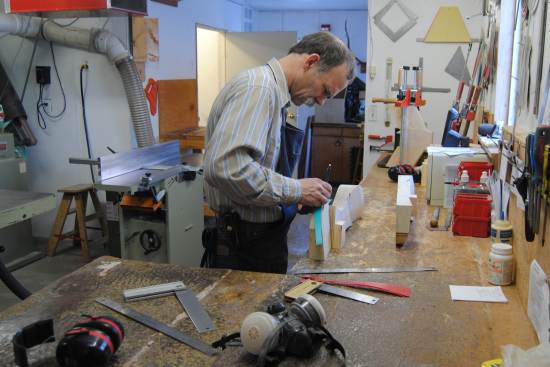
I figured that I wanted to show you that despite how wild and exciting everyone thinks the life of a tree maker to be, it really just goes along at a regular pace, day after day. So, here is what we did this week...
Monday
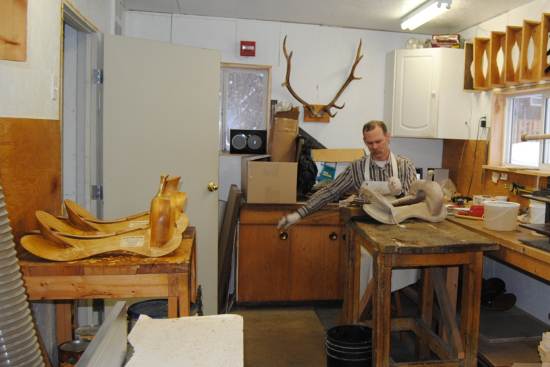
On Monday, Rod rawhided a couple of trees to go to Sweden. These are Buster Welch forks and the saddle maker calls them his "cowhorse" style trees. There are two more for the same maker to rawhide Tuesday waiting on the varnishing bench.
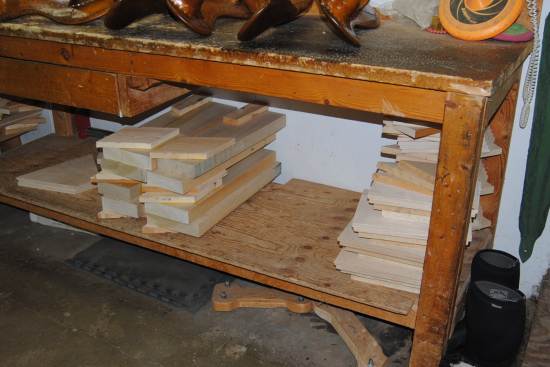
Waiting under the main bench is the wood for the next four trees glued up and marked out, ready for when Rod finishes rawhiding. I marked the patterns on them on Saturday, so they don't really belong in this post, but I wanted to show you the whole system so I put this picture in anyway.
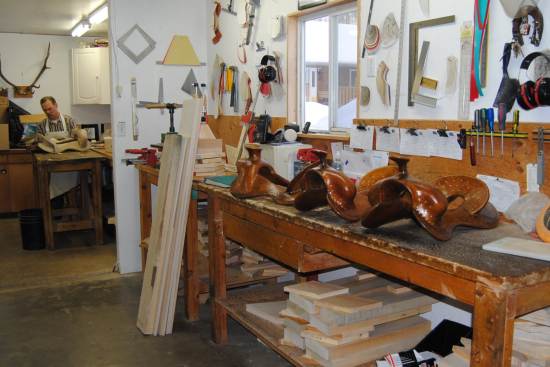
On the bench are three of the four trees ready to go. They were varnished at the end of last week. Today I did the final measuring up on them and took the series of nine pictures that I take on every tree (now that digital makes it cheap and easy). The wood stacked against the bench is there for a reason. I have it marked out in the pieces I need to glue up for next week's trees, but it isn't cut up yet. Behind it you can see the glue press in action with some of last week's pieces still being glued into Wade forks.
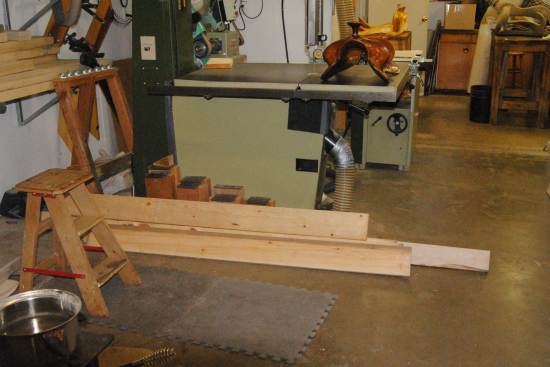
In front of the band saw, ready to trip up people who aren't careful, are more pieces of lumber I have marked out ready to cut into the appropriate pieces for me to glue up. One of the finished trees is on the bandsaw, where I measure them up. It is a true, flat surface so I can get accurate measurements there and also check for squareness.
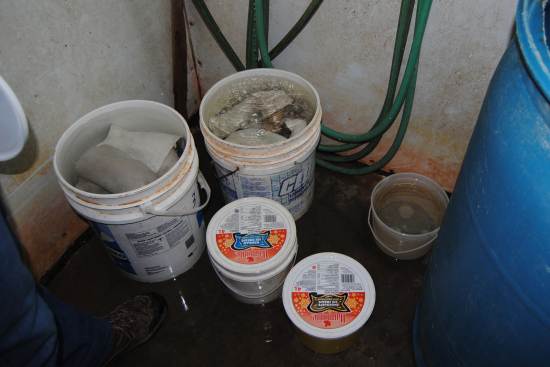
The five gallon pails each contain one tree's worth of hide, made up of four pieces - a large top cover, two pieces to cover the bottom of the bars and the piece for under the gullet. Rod changes water in the buckets twice a day while thawing and keeping the hide until it is used. Not a terribly exciting picture, or an terribly exciting part of the job. But it is one of those things that just takes time to do regularly. Like pounding trees... The ice cream buckets hold the deer hide lace he uses to sew the trees. It stays dry until the night before he plans to use it. Then it goes in a bucket with clean water and by the morning it is like spaghetti - ready to use.
Tuesday
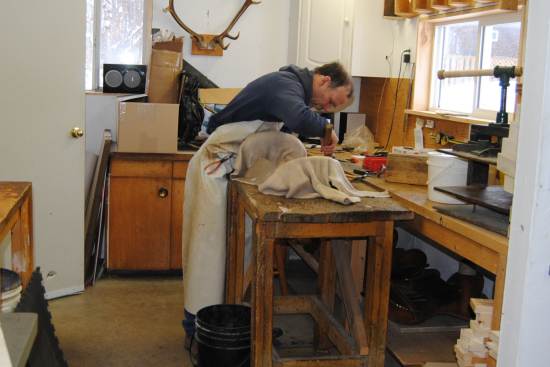
Rod rawhided the other two trees today. Here he's working on the cutting tree. The other one for the day was the Wade in Monday's pictures.
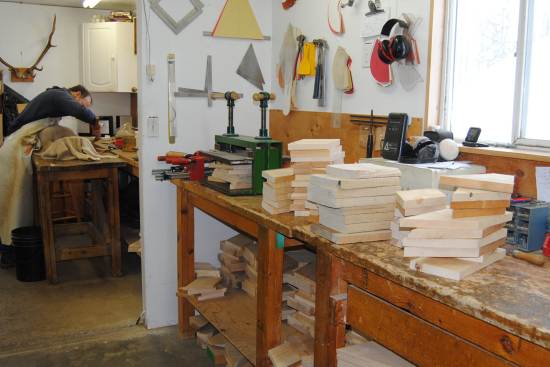
You can also see the glue press in use as I've got another Wade fork gluing up from pieces left over from last week. The wood on the bench at this stage has just been cut out. I also got the pieces planed and Rod worked with me to get them thicknessed that day. Thicknessing wood is the only job the two of us work at together in the shop. The conformation of the jointer/planer makes it much easier for two people to do this job than one.
What I don't have pictures of is packing up a couple of trees and doing a town trip to ship them off. Since we live half an hour from town, it is pretty much an afternoon shot when I do a town trip. We had really bad weather the end of last week - freezing rain that turned the roads to sheets of ice - so I hadn't been to town during working hours for a week, and I had quite the list.
Wednesday
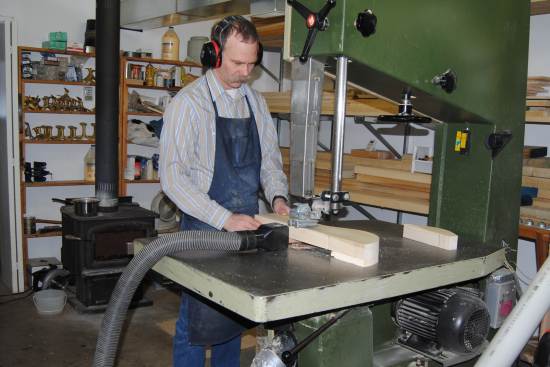
Today Rod started by cutting out the wood for the next four trees. It takes him about half a day to get it all cut out.
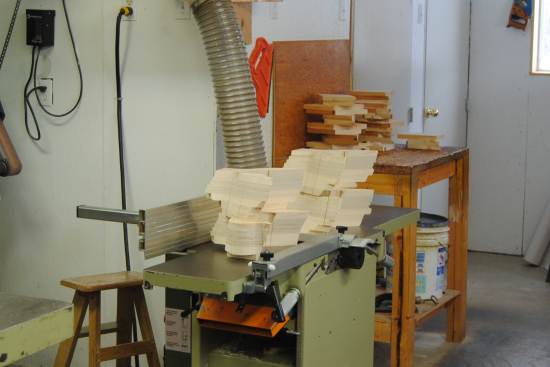
When I arrived in the shop (good thing my boss lets me come in late...) the forks were all cut out and sitting on the jointer/planer ready for me to plane to get them to the proper stock thickness for the order. Behind them on the varnish bench are the planed and thicknessed pieces of wood that I still needed to edge for laminating side to side.
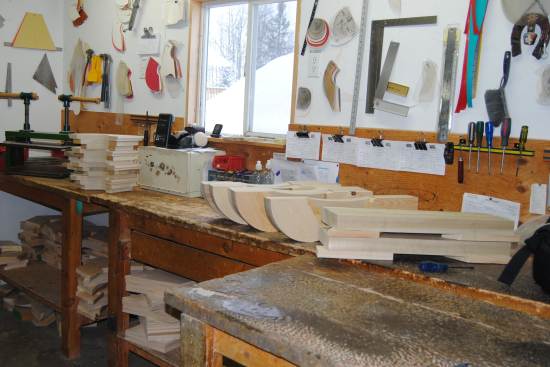
Rod was in the middle of cutting out the bars. Here three pairs have the outlines cut out, with the fourth left to go. He still had to use the jigs to make the fork and cantle cuts. Farther down the bench are the cantles he had cut the inside angle from. I needed to mark out the angle in the center before he could cut the bottom angle and the outline. (Please see the different pages in our Building a Tree section for more details on all the parts I am missing out.)
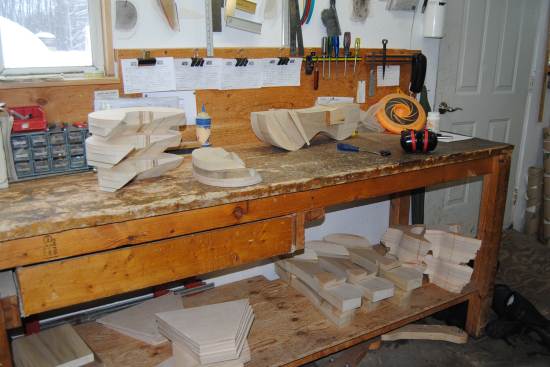
So here Rod has finished cutting out the cantles. The forks have been thicknessed and are under the bench waiting for their turn to be used, and the bars have their fork and cantle cuts done. Three are under the bench and the first one Rod will be building is up top, ready for him to start work on them.
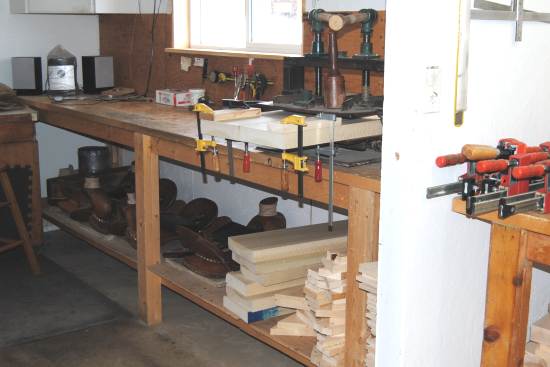
Meanwhile, I got a pair of bars gluing in the far glue press. The rest of the bar pieces are on the bench underneath, ready to go when the press is empty. I got a couple sets of them glued up on Wednesday.
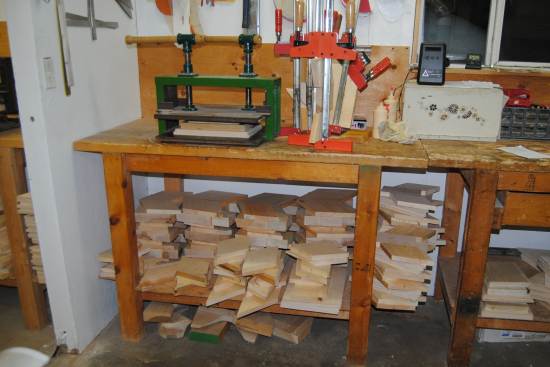
In this press a cantle is being glued up. Under the bench are the pieces of forks I will be gluing up the rest of the week - four Wades and a wood post 13 1/2" swell fork. The clamps up top are holding together layers for a couple Wades, getting them laminated side to side before they can be put in the glue press. By the end of the day, I had a couple of cantles done and two of the Wades glued edge to edge.
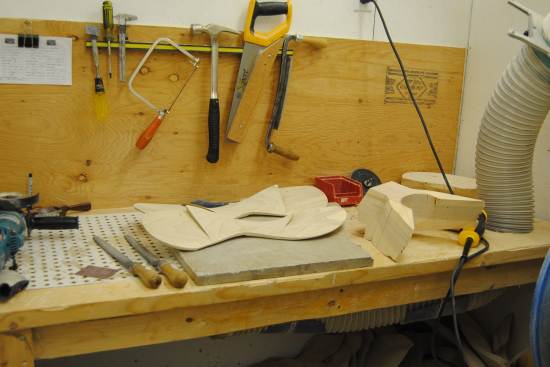
Rod got started on the first tree. He got the bars done and the top of the fork cut off, ready to start on the horn cap on Thursday.
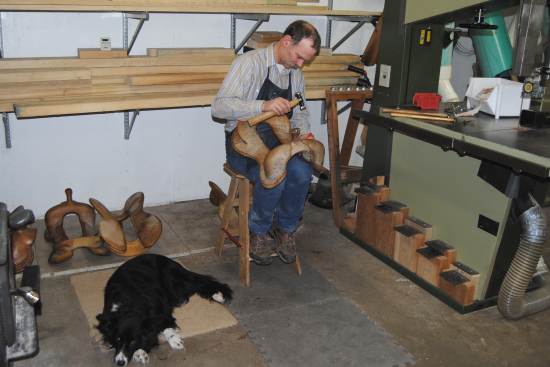
And then he had to pound trees. I don't have a lot of pictures of this, but it is a twice a day ritual - every day, Sundays included. The tree he is pounding now is one he rawhided the day before. You can see some areas going dark as they dry but a lot is still the lighter colour where they are still damp to the touch.
Thursday
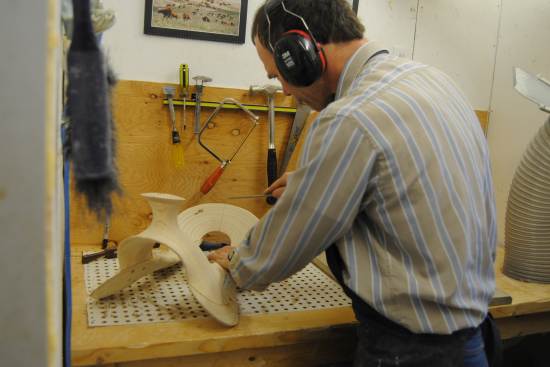
On Thursday Rod finished up the first tree of the week. It is a wood post slick fork with a Hope style horn and lip on it, but that is hard to see in this picture. It is also going to Sweden, but to a different maker than the four he rawhided earlier in the week. He is working on top of the downdraft table in the "dirty room". The dust collection system sucks the dust through the holes in the table and takes it away to the cyclone.
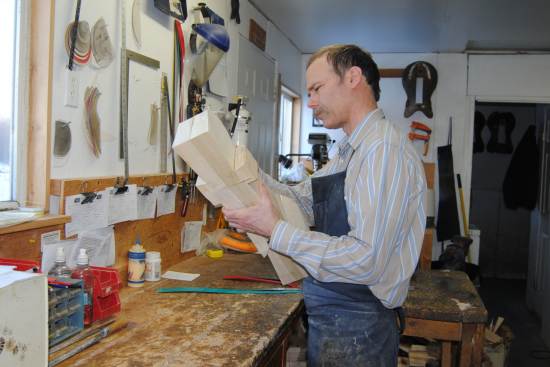
Then he got going on the next tree. Here he is marking out the edges of the bars. This sets the rock and twist and basic shape side to side for the set of bars.
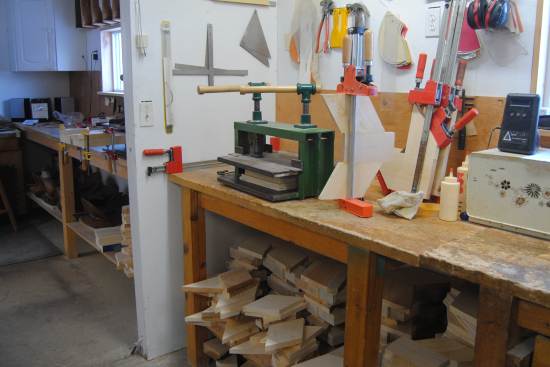
I was in town till early afternoon, but I got out to the shop in time to glue up another cantle, set of bars and wood post fork layers. You can see the one layer in front is quite wide. This will be the back layer on the 13 1/2" wide Will James that Rod will build next week.
Friday
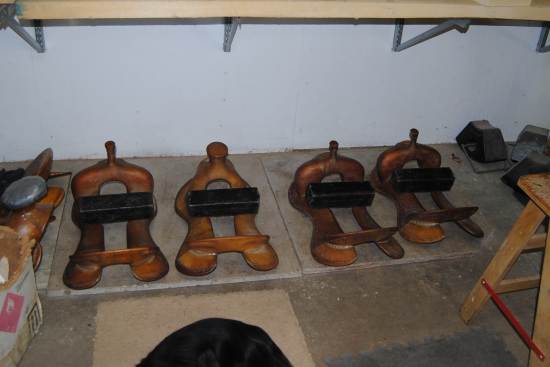
The trees from early this week are drying well. They are still a bit damp behind the cantles, as you can see from the lighter colour there, but they are dry enough that weighting them won't mark the rawhide now. The stone they are on is dead flat and keeping them weighted keeps the rawhide in line, as often rawhide prefers to do its own thing and can twist a tree while drying if not disciplined properly...
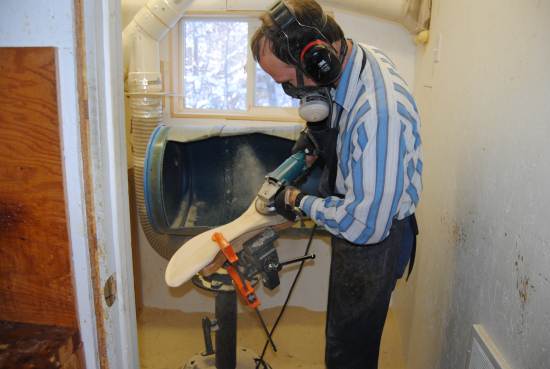
Here Rod is working on the next set of bars, shaping the bottoms with the side grinder. He has a plastic pattern in the pocket on the front of his apron that he uses as his template for the shape he wants to make. I took this picture through the door of the "dirty room" where he does all his grinding when he can't work outside. You can see the dust shooting away from the grinder towards the blue tub which acts as our dust collecting device with the port for our dust collection system in the bottom. It actually works fairly well, considering how far the grinder flings the dust. But you can still see the amount of sawdust on the floor, etc. This is why it is called the "dirty room", and why Rod always wears his mask when he works in there. It is also why he much prefers to work outside when at all possible. January - not possible...
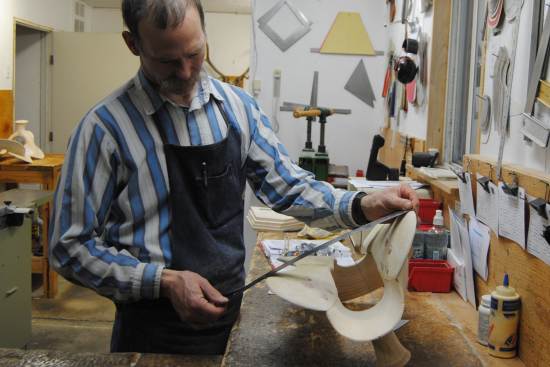
Here Rod is measuring up the finished tree while he waits for the body filler he uses to fill the screw holes to harden. We take many measurements of the trees that we record. Rod measures in the wood and I measure the finished tree in the rawhide. The information we gain from keeping track of the measurements has helped us learn a lot over the years.
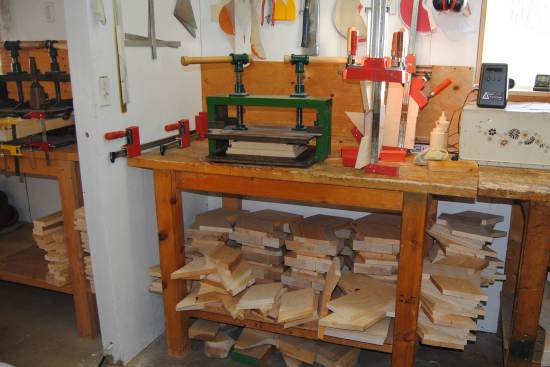
I got the last cantle and set of bars glued up in the morning along with the last set of edge to edge gluing I needed to get done for the forks. In the afternoon, I got started on gluing up forks in the press.
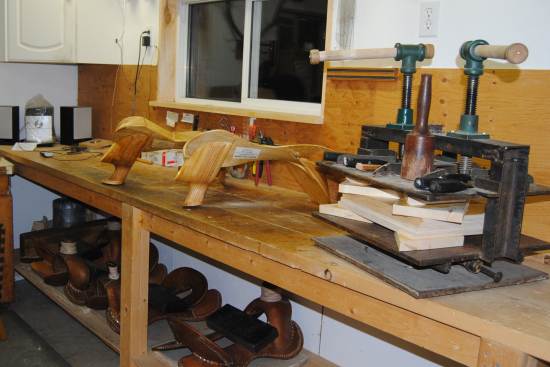
I gave the two finished trees their first coat of varnish at the end of the day while the 13 1/2" wide wood post fork was gluing in the press. Note the trees under the bench which are on their second week of drying. They will be varnished and ready to go sometime next week.
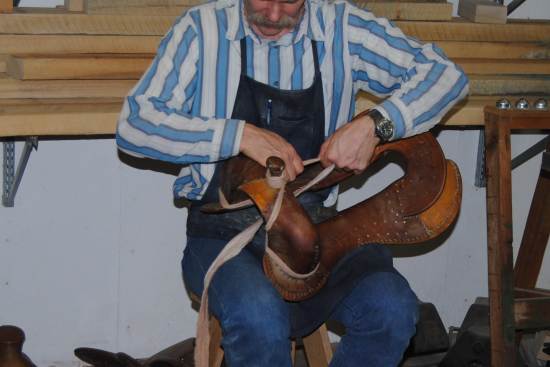
Part of babysitting the trees as they dry is wrapping the forks at just the right time. By wrapping a tensor bandage around the fork very tightly right where the gullet lip meets the bars, Rod can suck the rawhide into that corner and stop the stitches from pulling away from the wood. But there is only a small window of time to do this. When the hide is too wet, it will mark and pull away when you take the tensor off the next day. If it is too dry, you missed it and the tensor won't do anything. Over time, Rod has figured out just when that window of opportunity is, based on the feel and dryness of the hide, not the time since rawhiding the tree.
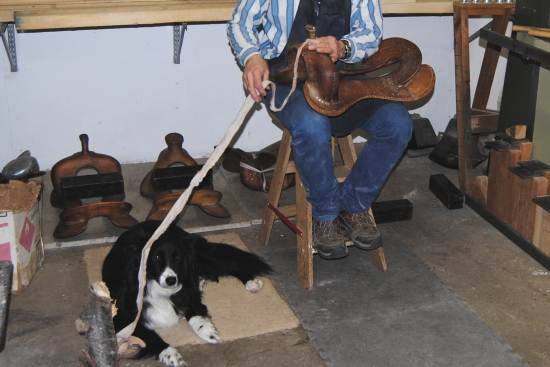
And, of course, Rod has to tease the poor dawg as he does this. Taylor the Wonder Dog has been our faithful shop assistant for over 13 years now. We can trust her with fresh rawhide - she won't touch it - and she puts up with noise and dust like a champ - as well as tensors being draped over and around her by bored tree makers. She more than earns her dog food, even the expensive veterinary diet she is now on.
Saturday
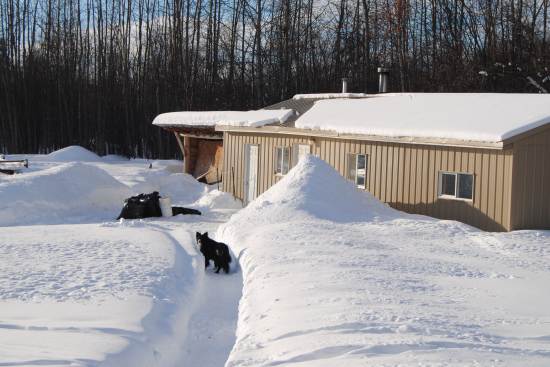
Yes, we work Saturdays around here.. We take Sundays off, except for pounding trees of course, but work the other six days of the week. It was a beautiful day today, nice and sunny and pretty close to the freezing mark - so I figured I would take yet another picture of the shop as I was heading out this morning. You can see how Rod has a path cleared to the shop and you get an idea of the amount of snow he has shovelled off the pad at the front by the size of the mound blocking the view from the window. The garbage bags out front contain the shavings and sawdust from about three weeks work. We take this over to some neighbours who use it as fill around their place, so the bags will leave the next trip we take over there in the truck (if we remember). The buckets contain the ashes from the wood stoves and they will be dumped the next time Rod gets rid of the extra rawhide as well. It looks a bit unsightly at the moment, but practicality comes in too, and with this amount of snow, leaving things where they are easy to get at has a purpose.
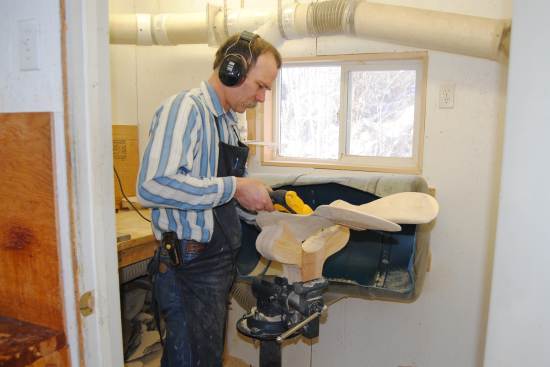
Today Rod was building a 14" wood post Will James tree. Here the bars are done and he is attaching the fork for the first time before marking out the gullet height and a couple other things. Then he takes it apart again and gets going on shaping the fork.
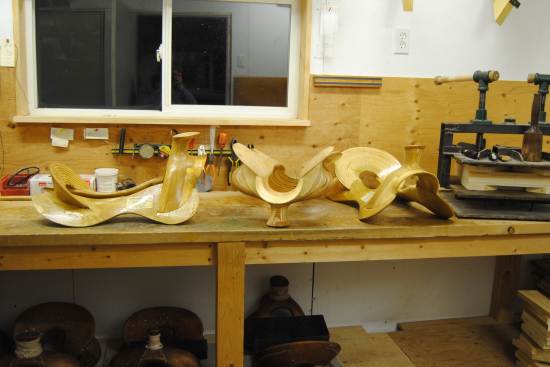
He got it done, and I got it varnished for the first time along with the other two trees which received their second coat of varnish tonight. This is a better picture of the tree with the Hope style horn and lip (on the left). When varnishing, I do the first coat so the trees are upside down, the second coat so they are right side up and the third upside down again. This changes the spots where the tree touches the bench so they always get at least one unmarred coat of varnish. And, as you can see in the glue press, I was still gluing up forks today.
While Rod can build and rawhide four trees in a week, that only happens when life goes very smoothly and nothing else interrupts his 8 am to 6 pm work in the shop for six days in a row. But life often intervenes, and it did this week. Rod had half a day clearing snow on Friday and a few phone calls from customers, while never a problem, also took some time. Then there were some things outside of work that took up some day time hours as well and... it is the end of the week with just three trees made and not four. Well, that is pretty normal, because while Rod can build and rawhide four trees in a week, we actually average between ten and twelve a month over the course of the year. So this really has been a pretty typical week for us in the shop.
But I had to leave you with a picture of the most typical, routine part of Rod's daily work...
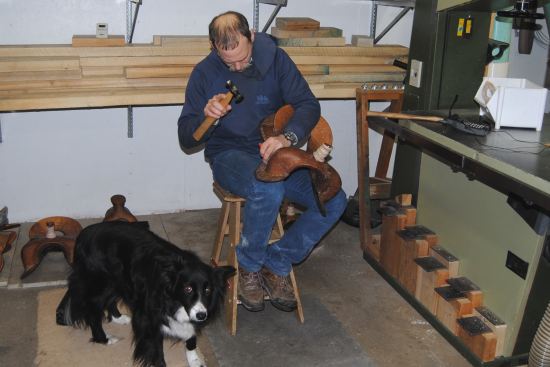
Rod pounding the trees at 5:48 pm on a Saturday to end off the week.
By the way, he gets to start next week at 8 am tomorrow morning - pounding trees before we head to church...
